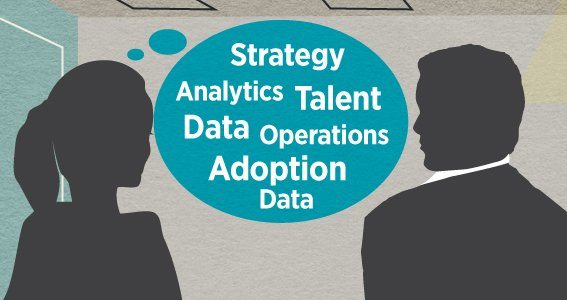Technology
Our Perspective on “Views From the Front lines of the Data‑analytics Revolution”
May 27, 2014

A recent piece in McKinsey Quarterly highlighted executive perspectives on the current realities and challenges of data analytics.McKinsey canvassed a variety of leaders (CIOs, CMOs, chief data officers and beyond) from some of the world’s biggest brands to gauge their reaction to five thematic questions:
-
Are data and analytics overhyped?
-
Do privacy issues threaten progress?
-
Is talent acquisition slowing strategy?
-
What organizational models work best?
-
What’s the best way to assure adoption?
We thought it would be interesting to consider these questions in a slightly different context: how do these challenges play out when we’re focused exclusively on marketing data and analytics versus general business intelligence?
—
Are data and analytics overhyped?
The McKinsey contributors asserted that data and analytics aren’t overhyped, but that they are oversimplified – that all too often there is a “helicopter view” of analytics instead of people embracing the reality that where and how analytics can improve business performance varies materially by company and industry.
We could not agree more on this point: all too often we see marketers relying exclusively on surface-level metrics (acquisition, repeat propensity, churn, etc) without digging into what lies beneath. In reality, while calculating metrics is scientific, qualifying the metrics that matter can also involve an element of art – for instance, if you are a retailer seeking to diagnose a decline in average order value, you will likely want to contextualize all of the factors that could be having an effect here before even diving into your calculations (for instance, what has changed in the UI or in the overall messaging, has AOV changed across the user base or just for some segments, etc).
Another key point was in working towards distinct “quick wins” and “longer-term, ground-breaking applications.” At Marigold Engage by Sailthru, we see marketing innovation requiring connection between incremental tweaks and making truly big bets. Several Sailthru clients, for instance, have found significant improvement in revenue per email sent by making just one change: powering content based on user behaviors vs. relying on a simpler “batch and blast” approach. This incremental tweak is mission-critical in the path to bigger bets; in fact, it often helps our clients see where the bigger opportunities lie. For many Sailthru clients the ground-breaking application is in working toward a “single template” approach to email marketing where they deploy one template with each send, from which all content would dynamically populate based on the end user profile. Again, in the example of a retailer, the email populates all content blocks with pertinent messaging and knows whether or not to give an incentive. The decision to give an incentive – and whether that be a free shipping offer, $20 or 20% off deal – would be automated as well. This is a longer-term application, but getting there requires that marketers deliver incremental value along the way to develop the business case.
Do privacy issues threaten progress?
The analytics leaders surveyed all agreed that companies should be placing more control of information in the hands of consumers. We could not agree more. As brands think about cultivating sustainable long-term relationships with customers, it is mission-critical to respect those end users and their preferences.
But, one of the big challenges for marketers today is that being borderline creepy often performs well in terms of ROI. We challenge marketers to play the long game here, and think about what those privacy considerations might do to obstruct longer-term brand equity. As marketers push for incremental gains, it’s important to recall the fine line between Big Data and Big Brother and embrace what Scott Bedbury, the marketing legend who helped build brands like Nike and Starbucks into what they stand for today, calls the “Spandex Rule of Branding:” just because you can (be invasive to generate financial gains), doesn’t mean you should.
Is talent acquisition slowing strategy?
The surveyed respondents talked extensively about seeking unicorns, or what they called “translators” – people whose talents bridge the disciplines of IT and data, analytics and business decision making. I would argue that the landscape differs a bit for the marketing function.
While there’s no doubt that all of those disciplines are strategically valuable to marketing organizations, the marketing rainmaker is typically what I call the “storyteller.” Storytellers are critical to B2C marketing organizations, where insights and analysis need to be quickly explained, digested and leveraged. Having started my own career on Wall Street and transitioning to marketing from there, I foolishly believed for years that any builder of an inspiring Excel model could be turned into a marketing analyst, but I’ve learned that’s not always the case and that marketing organizations struggle to find candidates who fit the bill on just two attributes: quantitatively-charged and in possession of a deep understanding of marketing frameworks that allow him or her to tell a compelling story with the data.
What organizational models work best?
Because this assessment focused on cross-functional business analytics, there was extensive discussion around centers of excellence (COE). The COE approach is undoubtedly an outstanding one, but it is often not a topic of discussion at smaller companies. Thinking about the segment that’s not ready for COEs, we have strong conviction that the best organizational models are those that avoid data silos.
That might sound obvious, but let’s just look at a typical marketing organization on its own to think this through further: all too often marketing is partitioned between acquisition (and then further into paid search vs. display, etc.), retention (and then product marketing vs. email, etc.) and so forth, with these units interacting only every so often. We have written about the power of leveraging retention to optimize acquisition in the past, but similar collaboration opportunities exist in many other parts of the business: think about the correlations between customer service and repeat purchase propensity. We highly encourage at least weekly KPI sharing sessions with different analytics owners to ensure that seemingly disparate data sets are being leveraged in every possible capacity.
What’s the best way to assure adoption?
The piece reiterated one of McKinsey’s common themes – that many companies “don’t invest enough, in time or money, to develop killer applications that combine smart, intuitive design and robust functionality” – and then highlighted two paths to help spur adoption: automation and training.
Our own experience with Marigold Engage by Sailthru clients has further corroborated the need for both, which is why we remain highly committed to evolving and expanding both our product suite and our arsenal of resources for our marketing partners. For example, it is precisely this reality that spawned our most recent product offering, Sailthru Advanced Analytics.
This solution provides marketers with highly flexible reporting on the 360-degree omnichannel customer. Clients using Advanced Analytics are not forced to invest extensive resources into scoping, building and scaling marketing intelligence in-house; rather, they now leverage our expertise in this area.
—
Cassie Lancellotti-Young is the VP of Client Optimization & Analytics at Sailthru where she is leading the revolution around 360-degree customer marketing and helping our clients maximize their marketing initiatives.
The State of Brand Loyalty in the U.S. in 2023
Related



